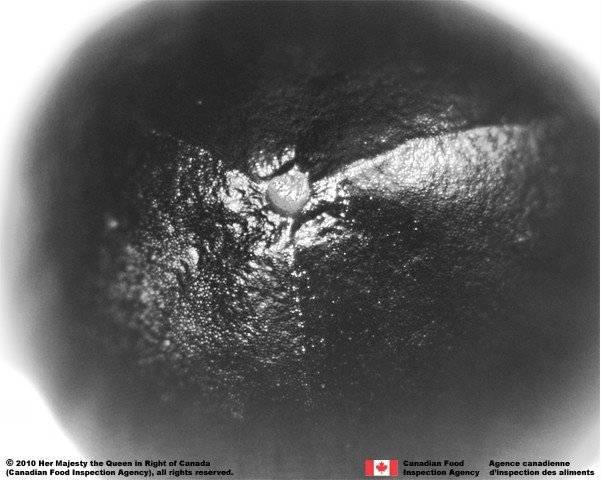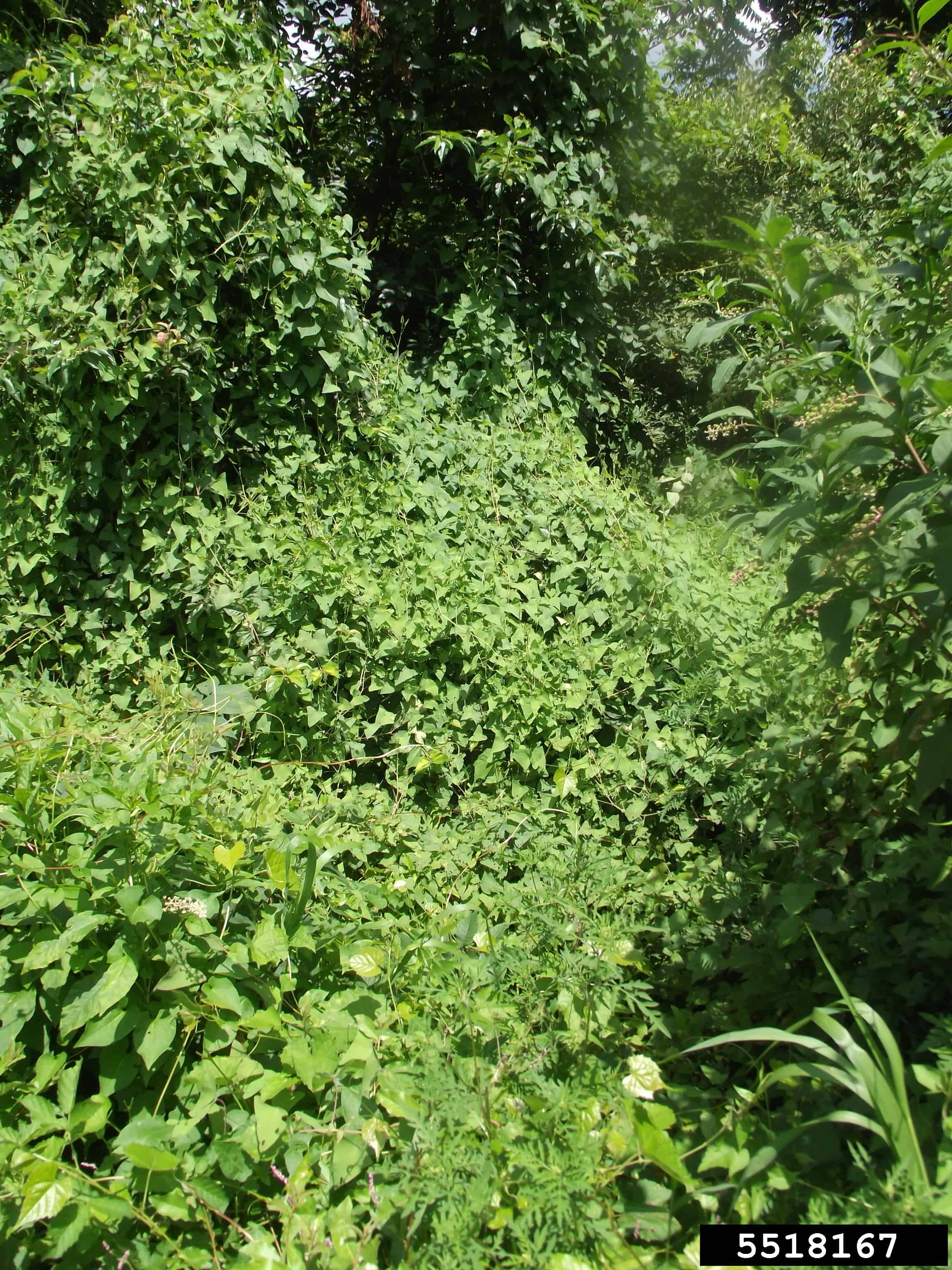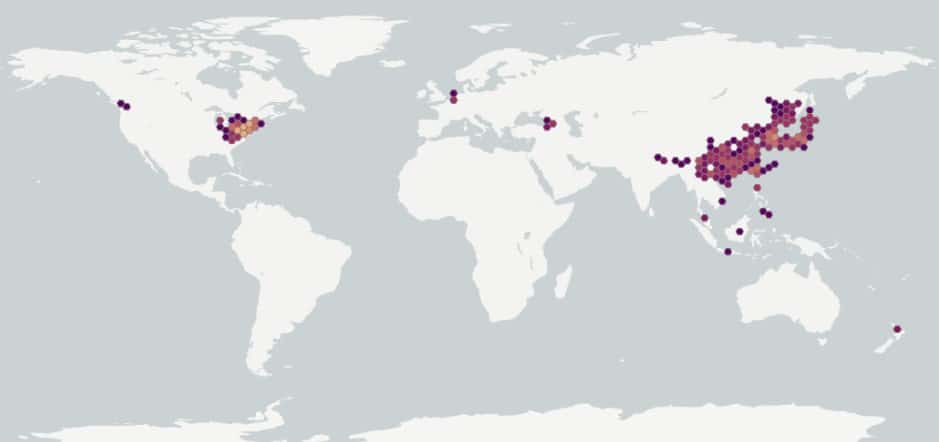Persicaria perfoliata
Overview
Aperçu
Regulation :
Remarques Réglementation:
- CFIA Weed Seeds Order - Class 1: Prohibited Noxious Weed Seeds
- List of Pests Regulated by Canada
- USA Federal Noxious Weed Seed List
Regulation Notes:
Prohibited Noxious, Class 1 in the Canadian Weed Seeds Order (2016) under the Seeds Act. All imported and domestic seed must be free of Prohibited Noxious weed seeds.
Distribution :
Répartition :
Native to Asia and present in India, China, Indonesia, Malaysia, Nepal, Korea, Japan, Bangladesh, Turkey, the Philippines, the Caribbean and northeastern United States (Kumar and DiTommaso 2005; CABI 2022; USDA-ARS 2022). Previously reported from British Columbia in Canada where populations failed to establish (Hill et al. 1981) and from Oregon where it did not persist (Kumar and DiTommaso 2005; CABI 2022).
Habitat and Crop Association :
Habitat et Cultures Associées :
Riparian areas as well as a wide variety of disturbed areas, including roadsides, hedges, fields, pasture and forest edges, early successional forests, plantations, gardens and parks (Kumar and DiTommaso 2005).
Economic Use, cultivation area, and Weed Association :
Utilisation économique, zone de culture et association de mauvaises herbes :
Duration of Life Cycle :
Durée du cycle vital:
Annual
Dispersal Unit Type :
Type d’unité de dispersion :
Achene, may remain in a fleshy perianth
General Information
RENSEIGNEMENTS GÉNÉRAUX
Persicaria perfoliata was introduced into the eastern United States in the 1940s with contaminated nursery stock (Poindexter 2010). It prefers moist to wet soils and is known for its rapid growth as well as its ability to suppress other species by smothering or shading (CABI 2022). Large infestations of P. perfoliata hamper movement due to its dense prickles (CABI 2022). This species was observed to be a prolific seed producer, primarily dispersed through birds, and buried achenes retained their viability after 2 years (Kumar and DiTommaso 2005).
.
Persicaria perfoliata infestation (Richard Gardner, Bugwood.org)
Identification
Identification
-
Perianth
Size
- Perianth diameter*: 3.6 – 5.0 mm
*Note: minimum and maximum of 20 achenes with perianth in a normal range of this species using image measurement (ISMA 2020)
Shape
- Perianth is globose
Surface Texture
- Perianth is smooth when fresh, generally wrinkled in dried specimens
Colour
- Perianth is dull dark bluish-purple, fading to light bluish-purple when dried
- When young the perianth is white or pink (Kumar and DiTommaso 2005)
Other Features
- Perianth tissue has a leathery consistency when dried
- Perianth is generally removed with seed processing, portions can remain attached to the truncate end of the achene

Persicaria perfoliata perianths



-
Achene
Size
- Achene diameter*: 3.4 – 3.9 mm
*Note: minimum and maximum of 20 achenes in a normal range of this species using image measurement (ISMA 2020)
Shape
- Achene is globose, slightly three-angled at one end with a white dot of tissue, and a truncate stump of tissue at the other end
Surface Texture
- Achene is smooth
Colour
- Achene is glossy black, some are straw yellow coloured at the base
Other Features
- Immature achenes are straw yellow turning black with age
- The achene retains perianth tissue at the truncate end if perianth is removed

Devil’s-tail tearthumb (Persicaria perfoliata) achenes





-
Seed
Size
- Seed diameter*: 3.0 – 3.5 mm
*Note: minimum and maximum of 5 seeds in a normal range of this species using specimen measurement (ISMA 2020)
Shape
- Seed is globose
Surface Texture
- Seed surface is rough
Colour
- Seed is opaque white with reddish seed coat
-
Embyro
Size
- Embryo partially fills the seed
Shape
- Embryo is curved
Endosperm
- Endosperm is white coloured, hard
Other Features
- Embryo is in a peripheral position around the outside of the seed
Identification Tips
CONSEILS POUR L’IDENTIFICATION
The combination of a persistent thick perianth and a black globose achene distinguishes P. perfoliata fruits from similar species.

Devil’s-tail tearthumb (Persicaria perfoliata) achene






Additional Botany Information
AUTRES RENSEIGNEMENTS BOTANIQUES
Flowers/Inflorescence
- Both sepals and petals white or pink and partially fused, 2.0 – 3.5 mm long, flower clusters of 1-3 along the flowering stem (FNA 1993+; Kumar and DiTommaso 2005)
- The perianth turns blue and fleshy as the achene develops (FNA 1993+)
- Pollination is not needed for the plant to set seed (Kumar and DiTommaso 2005)
Vegetative Features
- Stems are climbing and twining with prickles of 0.5 – 1 mm (FNA 1993+)
- Leaves are triangular and paper-like with prickles along the midribs on the undersides (CABI 2022)

Persicaria perfoliata fruits (Leslie J. Mehrhoff, University of Connecticut, Bugwood.org)




Similar Species
ESPÈCES SEMBLABLES
Similar species are based on a study of seed morphology of various species, and those with similar dispersal units are identified. The study is limited by physical specimen and literature availability at the time of examination, and possibly impacted by the subjectivity of the authors based on their knowledge and experience. Providing similar species information for seed identification is to make users aware of similarities that could possibly result in misidentification.
Persicaria arifolia (L.) Harald.
P. arifolia perianth appears thinner and the achenes are generally larger with length*: 3.3 – 3.8; width: 2.9 – 3.4 mm (length: 3.5 – 6.0 mm; width: 3.0 – 4.0 mm (FNA 1993+)). The achenes are lens-shaped in edge view and slightly pointed at the top compared to the globose achenes of P. perfoliata.
* Note: minimum and maximum of 10 seeds in a normal range of this species using image measurement (ISMA 2020)
Click to select species
Cliquez pour sélectionner les espèces

Persicaria arifolia
Comparison Window
Fenêtre de comparaison
MAIN SPECIES
ESPÈCES PRINCIPALES
Persicaria perfoliata

Persicaria perfoliata
Polygonaceae
Devil’s-tail tearthumb (Persicaria perfoliata) achenes
MAIN SPECIES
ESPÈCES PRINCIPALES
Persicaria perfoliata

Persicaria perfoliata
Polygonaceae
Persicaria perfoliata perianths
MAIN SPECIES
ESPÈCES PRINCIPALES
Persicaria perfoliata

Persicaria perfoliata
Polygonaceae
Devil’s-tail tearthumb (Persicaria perfoliata) achenes and perianth
MAIN SPECIES
ESPÈCES PRINCIPALES
Persicaria perfoliata

Persicaria perfoliata
Polygonaceae
Devil’s-tail tearthumb (Persicaria perfoliata) achene with perianth
MAIN SPECIES
ESPÈCES PRINCIPALES
Persicaria perfoliata

Persicaria perfoliata
Polygonaceae
Devil’s-tail tearthumb (Persicaria perfoliata) achene
MAIN SPECIES
ESPÈCES PRINCIPALES
Persicaria perfoliata

Persicaria perfoliata
Polygonaceae
Devil’s-tail tearthumb (Persicaria perfoliata) achene
SIMILAR SPECIES
ESPÈCES SEMBLABLES
Persicaria arifolia

Persicaria arifolia
Polygonaceae
Halberdleaf tearthumb (Persicaria arifolia) achenes
SIMILAR SPECIES
ESPÈCES SEMBLABLES
Persicaria arifolia

Persicaria arifolia
Polygonaceae
Halberdleaf tearthumb (Persicaria arifolia) achenes and perianths
SIMILAR SPECIES
ESPÈCES SEMBLABLES
Persicaria arifolia

Persicaria arifolia
Polygonaceae
Halberdleaf tearthumb (Persicaria arifolia) achene
Need ID Help?
Besoin d’aide pour l’identification?
Reference(s)
Référence(s)
Centre for Agriculture and Bioscience International (CABI). 2022. Invasive Species Compendium, CAB International, Wallingford, UK. https://www.cabidigitallibrary.org/journal/cabicompendium Accessed February 14, 2022.
Flora of North America (FNA) Editorial Committee, eds. 1993+. Flora of North America North of Mexico [Online]. 22+ vols. New York and Oxford. http://beta.floranorthamerica.org. Accessed December 29, 2022.
Global Biodiversity Information Facility (GBIF) Secretariat. 2022. https://doi.org/10.15468/39omei Accessed via https://www.gbif.org/species/4033648 Accessed December 29, 2022.
Government of Canada (GC). 2016. Canadian Weed Seeds Order. https://laws-lois.justice.gc.ca/eng/regulations/SOR-2016-93/page-2.html (English) https://laws-lois.justice.gc.ca/fra/reglements/DORS-2016-93/page-2.html (French)
Hill R.J., Spring G., Forer L.B., 1981. Mile-a-minute, Polygonum perfoliatum L. (Polygonaceae), a new potential orchard and nursery weed. Regulatory Horticulture, 7:21-32.
International Seed Morphology Association (ISMA). 2020. Method for Seed Size Measurement. Version 1.0. ISMA Publication Guide.
Kumar, V. and DiTommaso, A. 2005. Mile-a-minute (Polygonum perfoliatum): an increasingly problematic invasive species. Weed Technology 19: 1071–1077.
Poindexter, D. B. 2010. Persicaria perfoliata (Polygonaceae) reaches North Carolina. Phytoneuron 30: 1-9.
Tropicos. 2022. Missouri Botanical Garden. https://tropicos.org Accessed March 09, 2022.
U.S. Department of Agriculture-Agricultural Research Services (USDA-ARS). 2022. Germplasm Resources Information Network (GRIN), https://npgsweb.ars-grin.gov/gringlobal/taxon/taxonomysimple.aspx Accessed February 14, 2022.




